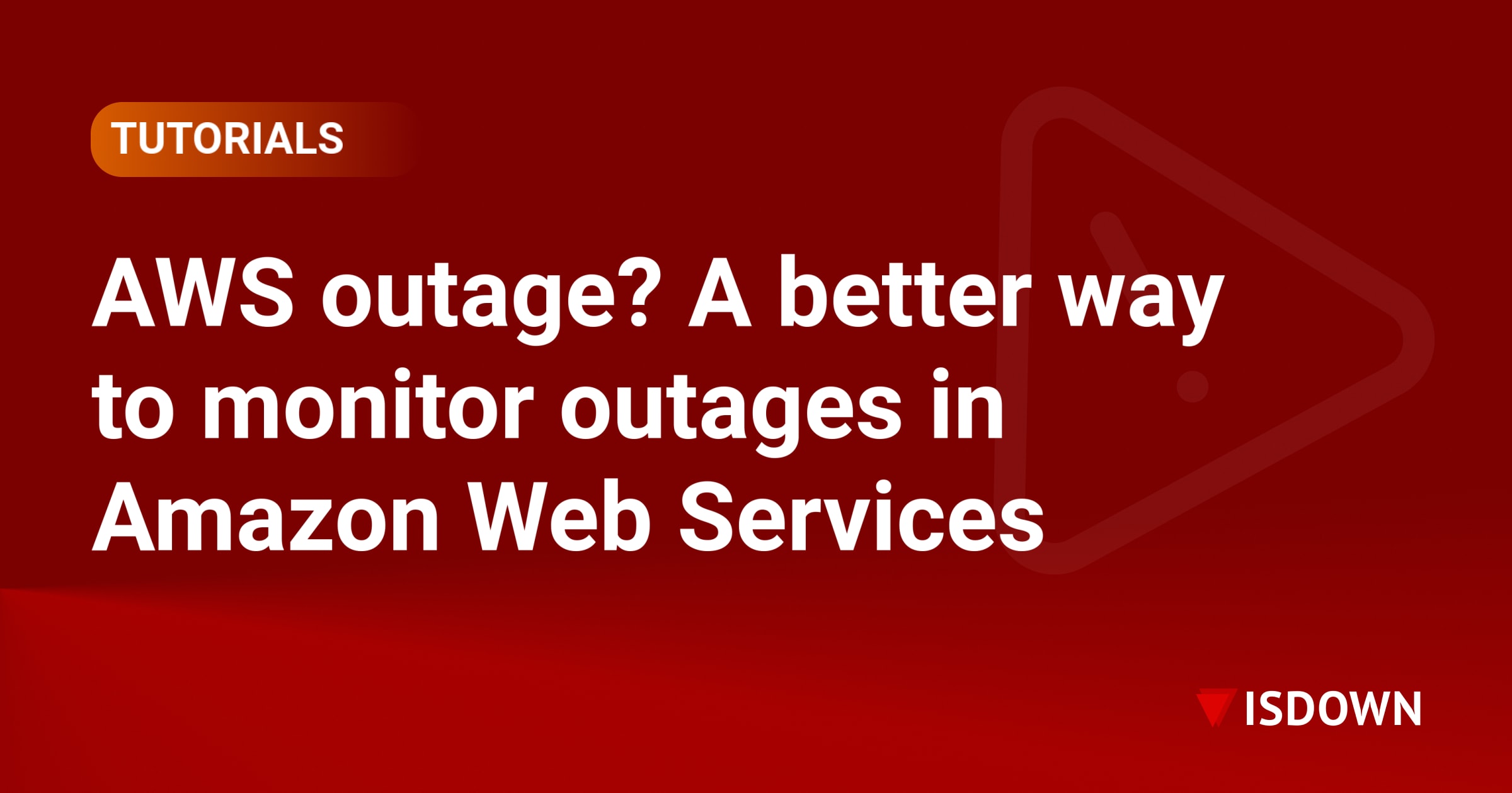Best StatusSight Alternatives for Vendor Monitoring

Vendor outages can cripple your business. Staying on top of their status is critical. Yet, manually monitoring every service you rely on can be time-consuming—not to mention error-prone. Plus, juggling multiple vendors, each with its own status page, makes it hard to get a clear picture.
StatusSight helps businesses track the availability of their critical service dependencies. To most, it can be a game changer. Yet, while StatusSight offers valuable monitoring, alternatives may provide broader coverage, deeper insights, or enhanced customisation. IsDown, EagleStatus, and DownDetector are among the widely used options.
On the other hand, while some users seek feature-rich platforms, others may prefer simpler alternatives with more basic functionality, like StatusTicker or Outage.Report. Down for Everyone or Just Me and IsTheServiceDown are also on the list.
We'll take a quick look at what status page solutions are, then explore each alternative going forward.
What is a Status Page Solution?
When services go down, businesses and users need real-time updates to assess the impact. This is where status pages and status page aggregators become essential.
A status page is an official resource provided by a service provider to display the current status of their systems, report incidents, and communicate maintenance updates. Companies like AWS, GitHub, and Cloudflare operate their own status pages to inform users about outages and performance issues.
A status page aggregator, on the other hand, consolidates multiple status pages into a single dashboard. Instead of checking various provider pages individually, users can see the status of multiple services in one place. Aggregators often enhance official data with crowdsourced reports, helping businesses and IT teams identify trends and respond proactively.
For organizations that rely on SaaS, cloud providers, or third-party tools, using a status page aggregator like IsDown, EagleStatus, or StatusSight streamlines monitoring and helps minimize disruptions.
StatusSight in a Nutshell
StatusSight is one of the many status page solutions out there. With a range of features for monitoring, it has its own notable perks and limitations.
How does it work?
It keeps track of the uptime and performance issues of websites, applications, and other online services. When an issue is detected, it sends alerts and updates the status page automatically, notifying users of the problem and its progress.
What Do Businesses Gain From It?
It helps businesses build trust by maintaining transparency and reducing support requests during downtime. Like most monitoring solutions, it provides a central point of information during outages, keeping customers informed, improving communication, and enhancing customer satisfaction.
What are its Limitations?
Some users would point out:
- Limited Integrations: StatusSight may have fewer integrations with other tools compared to some alternatives.
- Potentially Limited Customization: Some users might find StatusSight's customisation options for status pages to be somewhat restrictive.
- May lack high-level features for monitoring: Some advanced monitoring features may be missing or limited in StatusSight.
- Pricing may not be as transparent or flexible: StatusSight's pricing model might not be as transparent or offer the same level of flexibility as some competitors.
Best StatusSight Alternatives in 2025
Here are some of the leading status page solutions in 2025:
1. IsDown

IsDown is a modern third-party downtime monitoring platform that collects and combines service status updates in one place. It gathers data from official status pages and enhances it with crowdsourced insights, providing a clearer view of disruptions. By prioritizing official sources, IsDown delivers more reliable outage information than purely crowdsourced reports.
Key Features
- Customizable Notifications: Customizable notifications (Slack, Microsoft Teams, PagerDuty, Datadog)
- Real-time Updates: Real-time updates and historical outage data
- Status Pages: Public and private status pages (custom branding, password protection)
- Monitoring: Uptime, SSL certificate, and keyword monitoring
- Advanced Monitoring: Multi-location monitoring and maintenance window tracking
- Data Aggregation: Combined official status page and crowdsourced data
- Data Fusion: Merged crowdsourced insights with official updates
Advantages
- Accuracy: Ensures accurate monitoring. Specifically, it combines crowdsourced insights and status updates straight from the source.
- Notification Management: Prevents notification overload with customizable notifications.
- Integration: Integrates easily with existing procedures and tools.
- Real-time Updates: Enables rapid response to unexpected downtimes with real-time updates.
- User-Friendly Dashboard: Provides a user-friendly, visually appealing dashboard suitable for teams of all sizes.
- Free Trial: Offers a 14-day free trial without requiring a credit card or coding knowledge.
Disadvantages
- Onboarding: May require some onboarding for teams unfamiliar with status aggregation tools.
- Free Tier Limitations: Businesses relying exclusively on free tools might find it less accessible compared to consumer-orientated platforms.
Pricing:
- Flexible pricing based on usage. Starts at $37 per month.
- The most up-to-date pricing is available on their website.

2. StatusTicker

StatusTicker offers a simple and straightforward status page solution. It's designed for ease of use and quick setup, making it a good option for those who prioritize simplicity over extensive features.
Key Features
- Status Page: Basic status page display
- Setup: Easy setup and configuration
Advantages
- Navigation: Straightforward and easy to navigate
- Functionality: Offers a basic way to display service status
- Implementation: Quick to implement
Disadvantages
- Information: Limited information available
- Customization: Potentially limited customization options
- Advanced Features: May lack advanced features like incident management, detailed metrics, or integration with other monitoring tools. This simplicity can be a drawback for businesses needing more in-depth status communication. If these limitations don't meet your needs, check out our guide on StatusTicker alternatives for more feature-rich options.
- Suitability: Likely best suited for smaller services or internal use where a basic "up/down" indicator is sufficient.
Pricing:
- Prices start at $9 per month.

3. Down for Everyone or Just Me

Down for Everyone or Just Me is a free and readily accessible tool for quickly checking website availability. It's designed for simplicity and speed, ideal for those "is it just me?" moments.
Key Features
- Quick website availability check from multiple locations.
Advantages
- Quick confirmation of suspected outages: A fast way to check if a site is down.
- User-friendly: The simplicity of the tool makes it accessible to anyone, regardless of technical skills. All you have to do is enter the website URL.
- Free and easy to access: No account or setup required, and it's readily available to use.
- Checks from multiple locations: Provides a general idea of website availability across different regions.
Disadvantages
- Basic availability check: Limited to checking whether a site is up or down, without detailed performance metrics or advanced monitoring features.
- Simple HTTP requests: Typically uses basic HTTP checks, not advanced methods like response validation, page load times, or API endpoint checks.
- No alerts or integrations: Does not support setting up alerts or integrating with other services for ongoing monitoring.
- No historical data: Does not provide historical uptime data or detailed reports for performance tracking.
Pricing
- Free Service
4. Outage.Report

Outage.Report is a platform specifically focused on facilitating downtime reporting and tracking. It emphasises collaborative communication around incidents.
Key Features
- Down time reporting and tracking.
Advantages
- Focused Functionality: Specifically designed for downtime reporting and tracking.
- Collaboration: May facilitate collaboration and communication around outages.
- Centralized Information: Provides a central location for all information related to downtime incidents.
Disadvantages
- Limited Monitoring Information: Information on monitoring capabilities is limited.
- Pricing Information Unavailable: Pricing details are not readily available.
- Feature Set Unknown: The full range of features is unclear.
- Potential Reliance on User Reports: Accuracy and timeliness of information may depend on user reporting.
Pricing
- Free Service
5. Is The Service Down

Is The Service Down is a free and easily accessible online tool. It is specifically built for quickly checking website availability.
Key Features
- Website availability check: Checks if the website is online and functioning.
Advantages
- Ultra-Simplicity: It's arguably one of the simplest website checkers available. There's no account to create, no configuration, and often just a single field to enter the URL. This makes it incredibly accessible to anyone, even non-technical users.
- Focus on Immediate Checks: It's built for those "right now" moments when you suspect a site is down. You're not setting up ongoing monitoring; you're just getting a quick answer to a specific question.
- No Frills: It deliberately avoids any extra features. There are no alerts, reports, historical data, or customization options. This minimalist approach contributes to its speed and ease of use.
- Free and Public: It's typically a free, publicly available tool. This makes it accessible to anyone with an internet connection.
Disadvantages
- Basic functionality: no use of less sophisticated monitoring strategies such as those offered by status page solutions like IsDown or EagleStatus.
Pricing
- Free Service
6. StatusGator

StatusGator is a status page aggregator that tracks service disruptions from multiple cloud and SaaS providers in one place. It collects official status updates and alerts users about potential outages, helping businesses monitor their critical services more efficiently.
Key Features
- Multi-Service Monitoring: Tracks the status of thousands of SaaS and cloud services.
- Early Warning Alerts: Detects potential outages before official updates are posted.
- Customizable Status Pages: Allows users to create internal or public-facing status pages.
- Website Uptime Monitoring: Checks website availability and alerts users of issues.
- Real-Time Notifications: Sends alerts via Slack, MS Teams, email, SMS, and webhooks.
Advantages
- All-in-One Dashboard: Reduces the need to check multiple vendor status pages.
- Proactive Alerts: Helps teams respond to outages before they're officially acknowledged.
- Custom Branding: Status pages can be personalized with company logos and domains.
- Targeted Monitoring: Users can filter updates based on service components or regions.
Disadvantages
- Pricing Considerations: Some plans may be more expensive than other alternatives.
- Free Tier Limitations: Advanced features and historical data are restricted for free users.
- Not Self-Hosted: Requires reliance on the platform for maintenance and updates.
Pricing
- A free plan is available with limited features.
- Paid plan starts at $72/month (annual subscription).

7. EagleStatus

EagleStatus helps businesses monitor the health of interconnected systems, ensuring smooth operations and faster issue resolution. It emphasizes visualizing service dependencies to understand how different components impact each other.
Key Features
- Dependency Visualization: Tend to have a strong focus on visualizing service dependencies.
- System Monitoring: Monitoring of interconnected systems.
- Alerting: Alerting and notifications. (Likely, though specific details may vary)
- Status Pages: Status page functionality. (Likely, though customization details are unclear)
Advantages
- Impact Analysis: Can provide a clear picture of how interconnected services impact each other.
- Issue Resolution: Helps identify bottlenecks and cascading failures within complex systems.
- Proactive Monitoring: Allows businesses to proactively address issues. (Likely, but specifics may vary)
Disadvantages
- Customization: May have limited customization options for status pages. Businesses that prefer to have more control over the features of their status pages may want to explore EagleStatus alternatives that allow their desired adjustments.
- Feature Details: Specific details about alerting, reporting, integrations, and other features are not readily available.
- Pricing Complexity: While a free plan exists and paid plans start at $84 annually, the specifics of the paid plans (feature tiers, usage limits) are unclear.
Pricing
- A free plan is available
- Paid plan starts at $7/month (annual subscription).

8. DownDetector

DownDetector is a free platform that crowdsources outage information for a wide range of online services, leveraging a large community base.
Key Features
- Crowdsourced outage data: Relies on user reports to identify and track outages.
Advantages
- Large Community Base: Provides insights into widespread outages due to the volume of user reports.
- Broad Service Coverage: Covers a very broad range of services—from major social media platforms and cloud providers to smaller websites and online games.
- Early Outage Detection (Potentially): In some cases, user reports might flag an issue before official status pages are updated.
Disadvantages
- Accuracy Concerns: Relies on crowdsourced data; may not be entirely accurate, as user reports can be subjective or based on local issues.
- Limited Control: Offers limited control over the information presented, as it's based on user reports.
- Lack of Official Data: Businesses seeking more reliable information may prefer alternatives that incorporate official sources. Fortunately, some alternatives to DownDetector do just that. IsDown and StatusPal, for example, integrate both user-generated and official data, ensuring that the reports you receive are verified.
- Limited Customization: Offers limited customization and reporting capabilities.
- Potential for False Positives: Can be susceptible to false positives due to localized problems being reported as widespread outages.
- Delayed Information: Outage information might be delayed until a sufficient number of users report the issue.
Pricing
- Free Service
Why Alternatives Matter for Businesses
Businesses today increasingly rely on various web-based software and cloud-based services. Outages affecting these services can largely impact business operations, customer experience, and reputation. This makes a robust monitoring and incident communication strategy essential.
Factors to Consider When Choosing
Monitoring Requirements: Do you need to monitor uptime, website status, or service functionality? Identify the specific cloud or web-based services you rely on and whether you need basic or advanced monitoring to refine your options.
Integrations: Connecting your existing tools ensures a smooth workflow. Do you use communication platforms like Slack or Teams, incident management tools like PagerDuty, or payment apps? Webhooks can enhance automation, streamline alerts, and provide a unified system view.
Alerting: Real-time alerts are essential for quick responses to incidents. The tool should allow for customizable real-time notifications. Ideally, these alerts should be sent via preferred channels like SMS or email. To prevent alert fatigue, the tool should allow users to configure alert frequency and escalation policies.
Customisation: Does it have the ability to customize the status page, including public and private status pages, to match your branding? How about tailor it to your specific audience? These are valuable features.
Pricing: Evaluate your budget and usage needs carefully. Consider whether a free plan or free trial is sufficient for your needs or if you'll need a paid plan for advanced features. Some tools offer flexible pricing, while others offer per-user or per-month with an annual contract pricing.
Scalability: Choose a tool that can scale as your business grows. This includes the ability to monitor more services, handle more users, and integrate with new technologies.
Ease of Use: A user-friendly interface, intuitive navigation, and clear documentation are essential.
Support: Reliable support is essential. Look for vendors with a proven track record.
Conclusion
Choosing the right monitoring tool is a critical decision. Consider your monitoring needs carefully. Evaluate the strengths and weaknesses of each option. Take advantage of free trials or demos if you can.
Meanwhile, don't underestimate the importance of a robust monitoring strategy. IsDown, for example, offers:
- comprehensive monitoring, including public and private status pages
- uptime monitoring, up-to-the-minute notifications; and
- Unification via webhooks.
It is a great alternative for businesses and individuals who prefer reliable, wide-scale tracking of their vendor's service performance.
Solutions can range from simple tools to advanced monitoring options. It's important to choose one that offers the features you require for tracking outages, communicating with customers, and providing status updates. In the end, the best tool for you is what matches your needs and preferences the most. Reading about your options is a great big step.
Frequently Asked Questions for StatusSight Alternatives:
Can I monitor outages that affect SaaS services?
Yes, a lot of status page solutions are specifically designed to monitor general outages affecting Web-based software platforms. These solutions offer insights into issues across multiple services. It often includes those from providers like AWS. This ensures that you can keep track of potential disruptions.
How do I customize my status page?
Limited customisation options may also be available depending on the service. It's worth comparing solutions that fit your team's needs.
Are there free monitoring options available?
Yes. Downdetector offers free monitoring, which can be useful for basic tracking. If you seek more advanced monitoring, however, look for alternative services that provide additional features. These typically require a paid subscription. These are often billed per month with an annual plan for better pricing flexibility.
How can I communicate with my customers during an outage?
Preferred communication channels are key when dealing with outages and incidents. Many of these tools provide options to communicate real-time updates to customers and internal teams via status pages or alerts.
 Nuno Tomas
Founder of IsDown
Nuno Tomas
Founder of IsDown





